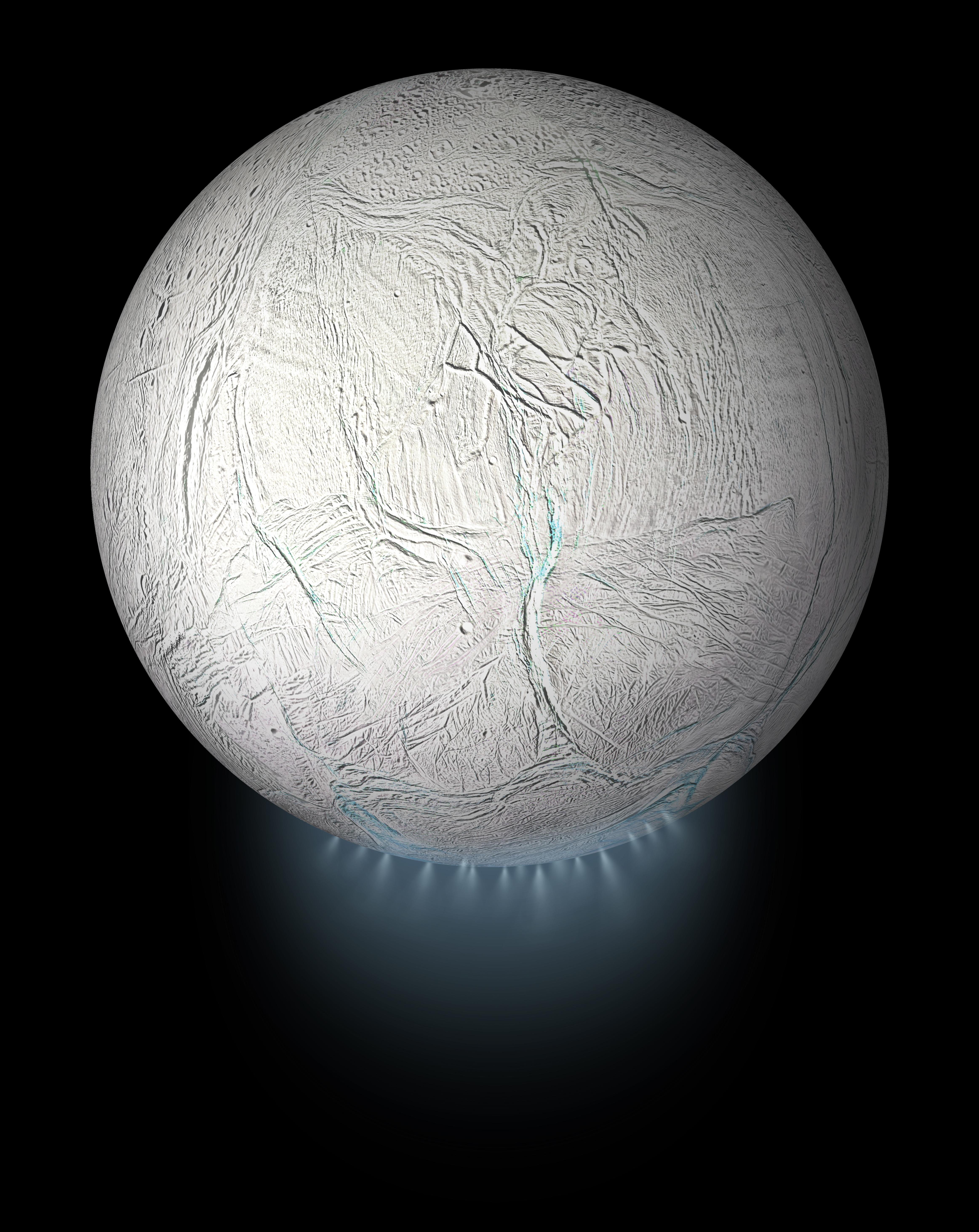
“Artist rendering of gaseous plumes emanating from the southern pole of Enceladus”
ABIOTIC METHANE?
https://sciencedirect.com/science/article/abs/pii/S0883292722001779
https://smithsonianmag.com/methane-detected-enceladus-may-be-biological-origin
Methane Detected at Enceladus May Be of Biological Origin
Here we go again: biology or unknown abiotic process?
by Dirk Schulze-Makuch / July 9, 2021
“An international scientific team led by Antonin Affholder from the University of Paris in France wanted to know whether the gases emanating from Saturn’s moon Enceladus are likely of chemical or biological origin. During close fly-bys of the moon ending in 2015, the Cassini spacecraft detected hydrogen and methane, among other gases, which implied the presence of hydrothermal activity in the liquid water ocean beneath Enceladus’s icy surface. Could these be analogous to hydrothermal vents like the “black smokers” on Earth, which are a haven for biology? Microbes living at these vents produce methane (and water) from hydrogen and carbon dioxide gas as part of their natural metabolic reactions. The science team used a method known as Bayesian statistics, where probability is expressed as a degree of belief based on prior obtained data and insights. They took mathematical models of known geophysical, geochemical, and biological processes, and included them in their statistical approach to quantify the plausibility of different hypotheses about Enceladus.
Methane can be an indicator of biology, but it can also form through an abiotic reaction that most commonly occurs in Earth’s oceanic crust, called serpentinization, which produces methane when water reacts with certain rock types. Affholder’s results showed that the methane concentrations measured in Enceladus’s gaseous plume are too high to be solely due to serpentinization. In fact, they concluded that the likeliest explanation is biology. Otherwise, to explain the high methane levels, an unknown abiotic process would have to be invoked. This reminds me of the controversy over phosphine at Venus, which also was presented as being explainable only by biology or an unknown chemical process. While the detection of methane and hydrogen in the Enceladus plume is undebatable (contrary to the phosphine detection at Venus), this study is still inconclusive, since we aren’t certain whether life is even possible inside Enceladus.
The moon’s ice-covered ocean may well be habitable now (I actually expect that), but if life requires Darwin’s “little pond” on a solid planetary surface to arise in the first place, it would not have developed on Enceladus. In general, environmental constraints for the origin of life are likely much more restrictive then for its presence. In other words, there may be many uninhabited habitable places in the galaxy. As long as we haven’t resolved this central question, I’m not certain whether statistical analyses like Affholder’s will really move us forward. But the question of life beneath the icy surface of Enceladus needs to be investigated. Any anomaly that we can’t readily explain needs to be looked at more closely. We might even have a stroke of luck. Let’s say the authors are correct about methanogenesis. If a follow-up mission to Saturn detects biology on Enceladus, it would tell us that hydrothermal vents are one place that life can originate.”
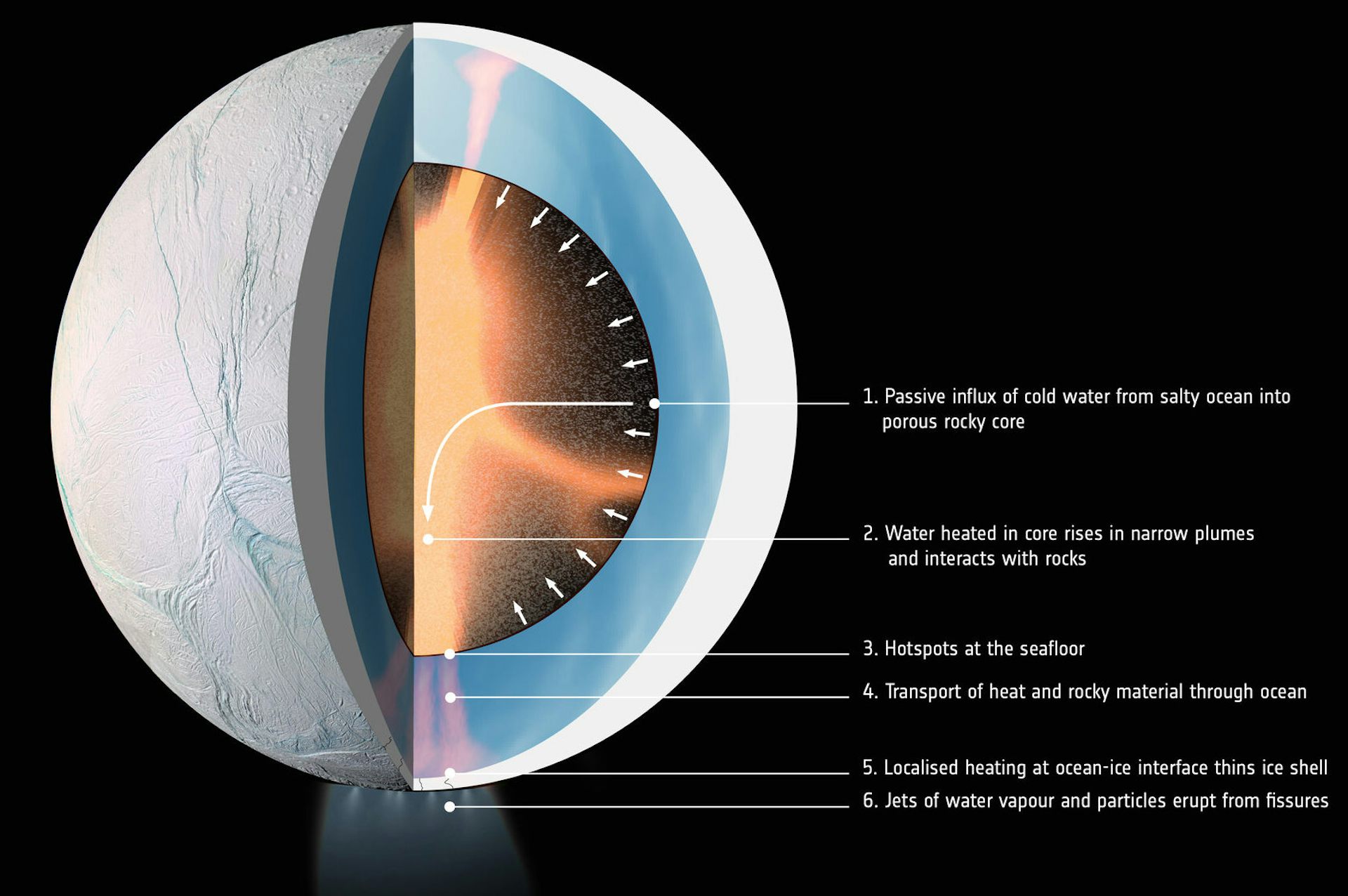
“The interior of Saturn’s moon Enceladus. Surface: NASA/JPL-Caltech/Space Science Institute; interior: LPG-CNRS/U. Nantes/U. Angers. Graphic composition: ESA“
or BIOTIC METHANE?
https://science.org/doi/10.1126/sciadv.adl0849
https://theconversation.com/saturns-moon-enceladus-able-to-support-life
Saturn’s ocean moon Enceladus is able to support life − my research team is working out how to detect extraterrestrial cells there
by Fabian Klenner / April 17, 2024
“Saturn has 146 confirmed moons – more than any other planet in the solar system – but one called Enceladus stands out. It appears to have the ingredients for life. From 2004 to 2017, Cassini – a joint mission between NASA, the European Space Agency and the Italian Space Agency – investigated Saturn, its rings and moons. Cassini delivered spectacular findings. Enceladus, only 313 miles (504 kilometers) in diameter, harbors a liquid water ocean beneath its icy crust that spans the entire moon. Geysers at the moon’s south pole shoot gas and ice grains formed from the ocean water into space. Though the Cassini engineers didn’t anticipate analyzing ice grains that Enceladus was actively emitting, they did pack a dust analyzer on the spacecraft. This instrument measured the emitted ice grains individually and told researchers about the composition of the subsurface ocean. As a planetary scientist and astrobiologist who studies ice grains from Enceladus, I’m interested in whether there is life on this or other icy moons. I also want to understand how scientists like me could detect it.
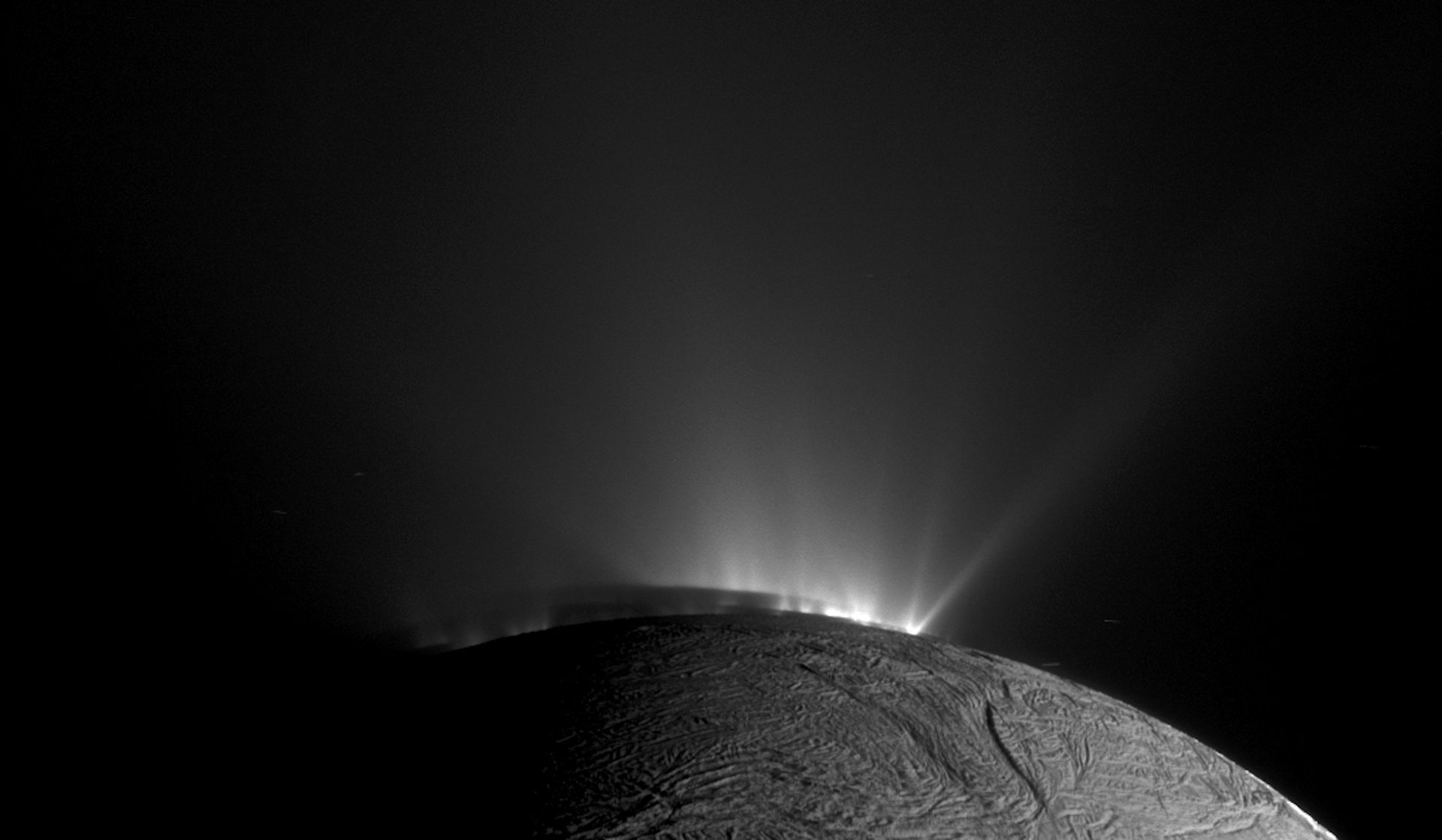
“The geyser basin at the south pole of Enceladus, with its water plumes illuminated by scattered sunlight. NASA/JPL-Caltech/Space Science Institute, CC BY”
Just like Earth’s oceans, Enceladus’ ocean contains salt, most of which is sodium chloride, commonly known as table salt. The ocean also contains various carbon-based compounds, and it has a process called tidal heating that generates energy within the moon. Liquid water, carbon-based chemistry and energy are all key ingredients for life. In 2023, I and others scientists found phosphate, another life-supporting compound, in ice grains originating from Enceladus’ ocean. Phosphate, a form of phosphorus, is vital for all life on Earth. It is part of DNA, cell membranes and bones. This was the first time that scientists detected this compound in an extraterrestrial water ocean. Enceladus’ rocky core likely interacts with the water ocean through hydrothermal vents. These hot, geyserlike structures protrude from the ocean floor. Scientists predict that a similar setting may have been the birthplace of life on Earth. As of now, nobody has ever detected life beyond Earth. But scientists agree that Enceladus is a very promising place to look for life. So, how do we go about looking?

“Baseline corrected cationic mass spectrum of the cell material equivalent
to one S. alaskensis cell in a 15-μm-diameter H2O droplet.”
In a paper published in March 2024, my colleagues and I conducted a laboratory test that simulated whether dust analyzer instruments on spacecraft could detect and identify traces of life in the emitted ice grains. To simulate the detection of ice grains as dust analyzers in space record them, we used a laboratory setup on Earth. Using this setup, we injected a tiny water beam that contained bacterial cells into a vacuum, where the beam disintegrated into droplets. Each droplet contained, in theory, one bacterial cell. Then, we shot a laser at the individual droplets, which created charged ions from the water and the cell compounds. We measured the charged ions using a technique called mass spectrometry. These measurements helped us predict what dust analyzer instruments on a spacecraft should find if they encountered a bacterial cell contained in an ice grain. We found these instruments would do a good job identifying cellular material. Instruments designed to analyze single ice grains should be able to identify bacterial cells, even if there is only 0.01% of the constituents of a single cell in an ice grain from an Enceladus-like geyser.

“Section (m/z 190 to 360) of a baseline corrected anionic mass spectrum
of the cell material equivalent to one S. alaskensis cell”
The analyzers could pick up a number of potential signatures from cellular material, including amino acids and fatty acids. Detected amino acids represent either fragments of the cell’s proteins or metabolites, which are small molecules participating in chemical reactions within the cell. Fatty acids are fragments of lipids that make up the cell’s membranes. In our experiments, we used a bacteria named Sphingopyxis alaskensis. Cells of this culture are extremely tiny – the same size as cells that might be able to fit into ice grains emitted from Enceladus. In addition to their small size, these cells like cold environments, and they need only a few nutrients to survive and grow, similar to how life adapted to the conditions in Enceladus’ ocean would probably be. The specific dust analyzer on Cassini didn’t have the analytical capabilities to identify cellular material in the ice grains. However, scientists are already designing instruments with much greater capabilities for potential future Enceladus missions. Our experimental results will inform the planning and design of these instruments.
Enceladus is one of the main targets for future missions from NASA and the European Space Agency. In 2022, NASA announced that a mission to Enceladus had the second-highest priority as they picked their next big missions – a Uranus mission had the highest priority. The European agency recently announced that Enceladus is the top target for its next big mission. This mission would likely include a highly capable dust analyzer for ice grain analysis. Enceladus isn’t the only moon with a liquid water ocean. Jupiter’s moon Europa also has an ocean that spans the entire moon underneath its icy crust. Ice grains on Europa float up above the surface, and some scientists think Europa may even have geysers like Enceladus that shoot grains into space.

“The SUrface Dust Analyzer instrument on Clipper will analyze ice grains from Jupiter’s moon Europa.NASA/CU Boulder/Glenn Asakawa“
Our research will also help study ice grains from Europa. NASA’s Europa Clipper mission will visit Europa in the coming years. Clipper is scheduled to launch in October 2024 and arrive at Jupiter in April 2030. One of the two mass spectrometers on the spacecraft, the SUrface Dust Analyzer, is designed for single ice grain analysis. Our study demonstrates that this instrument will be able to find even tiny fractions of a bacterial cell, if present in only a few emitted ice grains. With these space agencies’ near-future plans and the results of our study, the prospects of upcoming space missions visiting Enceladus or Europa are incredibly exciting. We now know that with current and future instrumentation, scientists should be able to find out whether there is life on any of these moons.”
[“Fabian Klenner, Postdoctoral Scholar in Earth and Space Sciences, University of Washington, is an affiliate of the Europa Clipper mission (SUrface Dust Analyzer instrument). He receives funding from NASA.”]
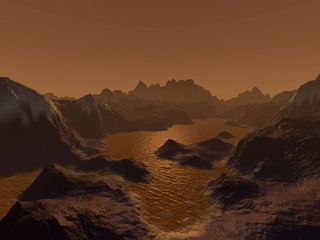
“An artist’s imagination of hydrocarbon pools, icy and rocky terrain on the surface of Saturn’s largest moon Titan” credit: Steven Hobbs
THOLIN FORMATION at HIGH ALTITUDES
https://planetary.org/what-in-the-worlds-are-tholins
https://space.com/4968-titan-oil-earth.html
Titan Has More Oil Than Earth / February 13, 2008
“Saturn’s smoggy moon Titan has hundreds of times more natural gas and other liquid hydrocarbons than all the known oil and natural gas reserves on Earth, scientists said today. The hydrocarbons rain from the sky on the miserable moon, collecting in vast deposits that form lakes and dunes. This much was known. But now the stuff has been quantified using observations from NASA’s Cassini spacecraft. “Titan is just covered in carbon-bearing material — it’s a giant factory of organic chemicals,” said Ralph Lorenz, a Cassini radar team member from the JohnsHopkins University Applied Physics Laboratory. “This vast carbon inventory is an important window into the geology and climate history of Titan.” At minus179 degrees Celsius (minus 290 degrees Fahrenheit), Titan would be an awful place to live. Instead of water, liquid hydrocarbons in the form of methane and ethane are present on the moon’s surface, and tholins probably make up its dunes.
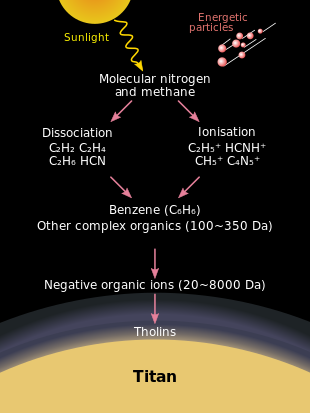
“The formation of tholins in the atmosphere of Titan“
The term “tholins” was coined by Carl Sagan in 1979 to describe the complex organic molecules at the heart of prebiotic chemistry. Titan has long been viewed as a place that might be somewhat like Earth just before biology got going. Cassini has mapped about 20 percent of Titan’s surface with radar. Several hundred lakes and seas have been observed, with each of several dozen estimated to contain more hydrocarbon liquid than Earth’s oil and gas reserves, according to a NASA statement. The dark dunes that run along the equator contain a volume of organics several hundred times larger than Earth’s coal reserves. Proven reserves of natural gas on Earth total 130 billion tons, enough to provide 300 times the amount of energy the entire United States uses annually for residential heating, cooling and lighting, according to the release.
Dozens of Titan’s lakes individually have the equivalent of at least this much energy in the form of methane and ethane. “This global estimate is based mostly on views of the lakes in the northern polar regions,” Lorenz said. “We have assumed the south might be similar, but we really don’t yet know how much liquid is there.” Cassini’s radar has observed the south polar region only once, and only two small lakes were visible. The findings are detailed in the Jan. 29 issue of the journal Geophysical Research Letters. Scientists estimated Titan’s lake depth by making some general assumptions based on lakes on Earth. They took the average area and depth of lakes on Earth, taking into account the nearby surroundings, like mountains. On Earth, the lake depth isoften 10 times less than the height of nearby terrain. “We also know that some lakes are more than 10 meters or so deep because they appear literally pitch-black to the radar. If they were shallow we’d see the bottom, and we don’t,” Lorenz said.
NASA's Galileo spacecraft captures a flames of an active volcano on Jupiter’s Io moon. pic.twitter.com/lGqU0UKR4j
— Brian Roemmele (@BrianRoemmele) April 16, 2024
The question of how much liquid is on the surface is an important one because methane is a strong greenhouse gas on Titan as well as on Earth, but there is much more of it on Titan. If all the observed liquid on Titan is methane, it would only last a few million years, because as methane escapes into Titan’s atmosphere, it breaks down and escapes into space. If the methane were to run out, Titan could become much colder. Scientists believe that methane might be supplied to the atmosphere by venting from the interior in cryovolcanic eruptions. If so, the amount of methane, and the temperature on Titan, may have fluctuated dramatically in Titan’s past. “We are carbon-based life, and understanding how far along the chain of complexity towards life that chemistry can go in an environment like Titan will be important in understanding the origins of life throughout the universe,”Lorenz said.”
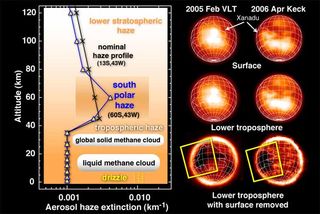
“Near-infrared images of Titan’s surface and lower troposphere can be subtracted to reveal widespread cirrus-like clouds of frozen methane (lower images) and a large patch of liquid methane (dark area within box) interpreted as clouds and morning drizzle above the huge continent of Xanadu (outline). At left is a chart of Titan’s aerosol haze versus altitude. (Image credit: Mate Adamkovics/UC Berkeley)”
FROZEN METHANE CLOUDS, with WAXY SNOWFLAKES
https://space.com/floating-islands-saturn-moon-titan-snow
https://space.com/4470-titan-dreary-drizzle.html
Today On Titan, A Dreary Drizzle
by Jeanna Bryner / October 11, 2007
“Future settlers take note: Galoshes and umbrellas are a must on Saturn’s moon Titan, where mornings are eclipsed by dreary drizzles of methane. Getting drenched would be the least of your worries, however, as Saturn’s largest satellite plunges to a bone-chilling -297 degrees Fahrenheit (-183 degrees Celsius) at the surface and its swirling orange atmosphere is full of hydrocarbons, such as methane, which is natural gas—and no oxygen. “Crude oil minus the sulfur is a decent estimate of what the haze is,” said lead author of a new study of Titan’s weather, Mate Adamkovics, an astronomer at the University of California, Berkeley. “Really we don’t know for sure, but I would describe it as tiny particles of wax that are really, really cold, or waxy snowflakes.” Adamkovics added that while scientists are not sure how toxic the particles are, the lack of oxygen would be much more of a hazard.
Using near-infrared images from Hawaii’s W. M. Keck Observatory and Chile’s Very Large Telescope, the team of astronomers reveals a nearly global cloud cover at high elevations on Titan. They also found persistent morning drizzle made of methane over the western foothills of Xanadu, Titan’s largest “continent.” Measuring about 3,200 miles (5,150 kilometers) across, Titan is larger than Mercury and Pluto and about 40 percent the diameter of Earth. It is the only moon in the solar system with a dense, planet-like atmosphere (10 times denser than Earth’s). As is the case on Earth, where features like lakes and mountains can morph and direct weather systems, Titan’s terrain also could be a rain maker. “Titan’s topography could be causing this drizzle,” said study team member Imke de Pater, an astronomy professor at UC Berkeley. “The rain could be caused by processes similar to those on Earth: Moisture laden clouds pushed upslope by winds condense to form a coastal rain.” The new findings, detailed in the Oct. 11 issue of Science Express, an online version of the journal Science, provide strong evidence supporting past cloud-cover observations and possible indicators of methane drizzle over parts of Titan.
In 2005, the Huygens probe that had been aboard NASA’s Cassini spacecraft gathered data supporting the existence of frozen methane clouds at higher elevations and liquid methane clouds, with possible drizzle, lower in the atmosphere. But the extent of such clouds was unclear. “A single weather station like Huygens cannot characterize the meteorology on a ‘planet-wide’ scale,” said UC Berkeley astronomer Michael Wong, who was part of the recent study. And until now, liquid rain was inferred from reports of lakes of liquid hydrocarbon, which scientists presumed were filled by methane precipitation. Adamkovics and his team analyzed infrared measurements throughout Titan’s atmosphere. By subtracting out the absorption and scattering due to aerosols low in the atmosphere as well as light from the surface, they were left with a signal that was due to actual droplets of liquid methane. Using a “radiative transfer model,” the scientists distinguished between miniscule drops inside clouds and larger ones that form drizzle.
The results paint a dreary picture with a global cloud of frozen methane hovering at a height of about 16 to 22 miles (25 to 35 kilometers), liquid methane clouds below 12 miles (20 kilometers) and drizzling methane at lower elevations. “We show that the solid cloud covers the globe and the drizzle happens predominantly in the morning,” Adamkovics told SPACE.com. The methane droplets inside Titan’s clouds are estimated to be a thousand times larger than those in terrestrial clouds. Yet, both contain similar moisture contents, Adamkovics said. And if a cosmic cloud wringer were to empty out Titan’s clouds, about six-tenths of an inch (1.5 centimeters) of water would blanket the moon’s surface. The drizzle or mist appears to dissipate after about 10:30 a.m. local Titan time, which is about three Earth days after sunrise. Titan takes nearly 16 Earth days to rotate once.”
“…The discovery of lakes on Titan (especially those with no discernible source channels), and the likelihood of atmospheric methane replenishment from an interior source, have prompted some workers to consider the viability of a Titanian methane aquifer…”
SUB-SURFACE METHANOFERS
https://nature.com/articles/s41550-019-0714-2
https://space.com/2681-lakes-saturn-moon-titan.html
Lakes Found on Saturn’s Moon Titan
by Robert Roy Britt / July 28, 2006
“One of the major goals of NASA’s Cassini mission was to find lakes or seas on Saturn’s moon Titan. Now scientist say they’ve found lakes. These are not bodies of water like those on Earth, but rather dark lakes of methane and possibly ethane. They are likely the source of the hydrocarbon smog in the moon’s atmosphere that has long made it impossible to even see the surface. Several dark patches, some with channels running out of them, were spotted near Titan’s north pole during a July 22 Cassini flyby, NASA said in a statement yesterday. “This is a big deal,” said Steve Wall, deputy radar team leader at NASA’s Jet Propulsion Laboratory. “We’ve now seen a place other than Earth where lakes are present.”

“The Cassini spacecraft, using its radar system, has discovered very strong evidence for hydrocarbon lakes on Titan. Dark patches, which resemble terrestrial lakes, seem to be sprinkled all over the high latitudes surrounding Titan’s north pole.”
This was Cassini’s first look at the region. Its radar, which penetrates the smog, was used to find several dozen lakes ranging from less than a mile wide to one that is about 62 miles long. “What we see is darker than anything we’ve ever seen elsewhere on Titan. It was almost as though someone laid a bull’s-eye around the whole north pole of Titan, and Cassini sees these regions of lakes just like those we see on Earth,” said Larry Soderblom, Cassini interdisciplinary scientist at the U.S. Geological Survey, Flagstaff, Ariz. On radar, dark areas indicate smoother terrain. These apparent lakes are so dark that the scientists assume they must be liquid. Any water on Titan would be constantly frozen, however, so the assumption is these lakes are made of hydrocarbons, which can stay liquid at much colder temperatures.
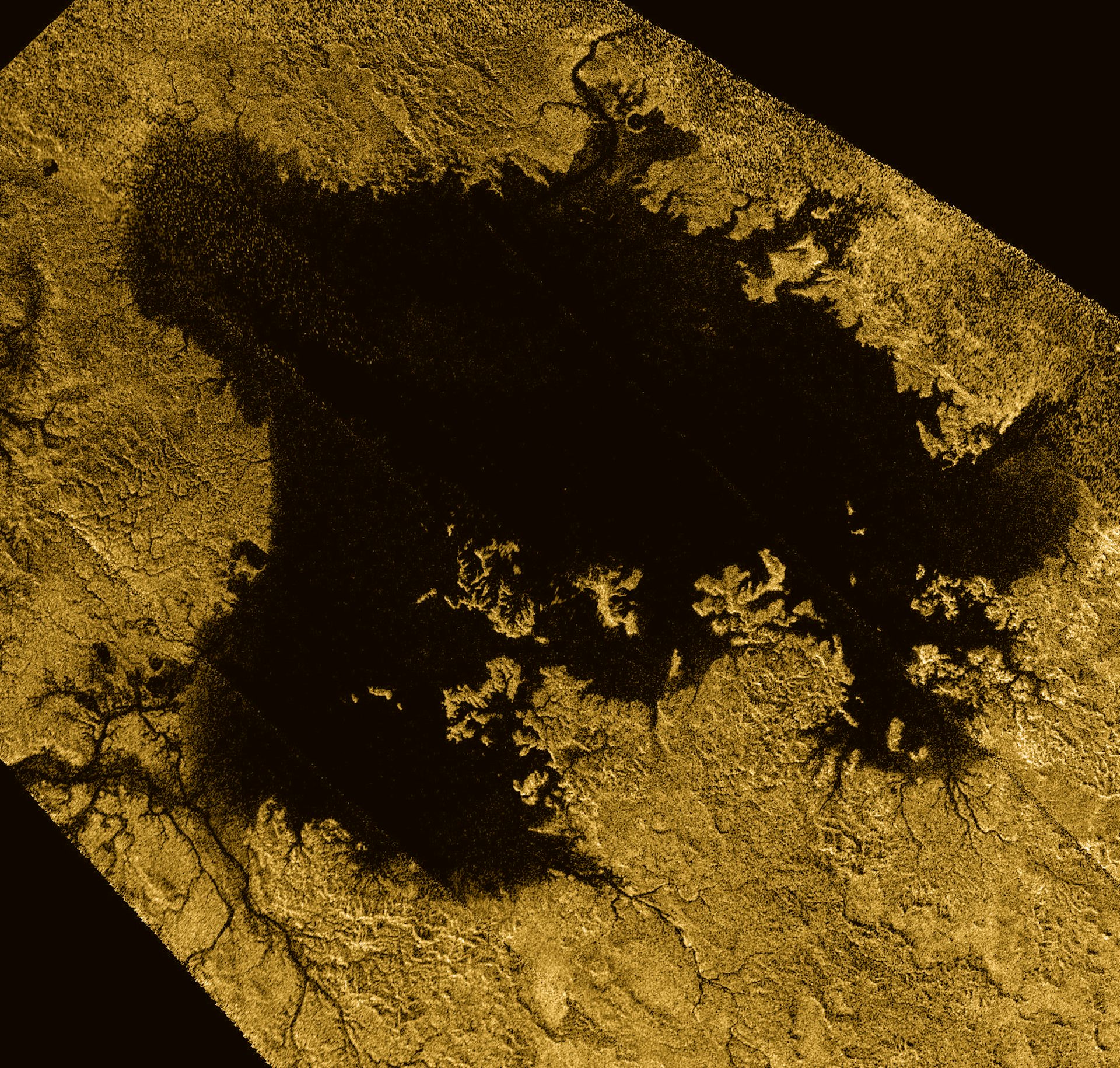
“False-color image of Ligeia Mare, the second largest known body of liquid on Saturn’s moon Titan. It’s filled with liquid hydrocarbons.NASA/JPL-Caltech/ASI/Cornell, CC BY“
The shapes of outflow channels strongly suggest liquid carved them, the researchers say. “We’ve always believed Titan’s methane had to be maintained by liquid lakes or extensive underground ‘methanofers,’ the methane equivalent of aquifers,” said Jonathan Lunine, a Cassini scientist at the University of Arizona. “We can’t see methanofers but we can now say we’ve seen lakes.” Lakes should change shape slightly with the seasons, and winds ought to roughen their surfaces, so future passes by Cassini will look for these effects. Other Cassini observations have revealed apparent river channels elsewhere on the moon, as well as shorelines that might represent lakes or seas. Scientists say the moon likely experiences methane rains. But most observations, until now, have not shown conclusively that the methane exists in large quantities in liquid form now.”
PREVIOUSLY
HEAVY METAL SNOW
https://spectrevision.net/2023/12/27/heavy-metal-snow/
LIFE WITHOUT SUNLIGHT
https://spectrevision.net/2021/06/01/subsurface-biomes/
BIOSIGNATURES on VENUS
https://spectrevision.net/2020/09/18/biosignatures-on-venus/
ABIOTIC OIL
https://spectrevision.net/2020/01/27/deep-hot-biosphere/
EARTH’s PLASMA CORE
https://spectrevision.net/2020/01/22/plasma-core/
ABRUPT THAWING
https://spectrevision.net/2019/10/09/abrupt-thawing/